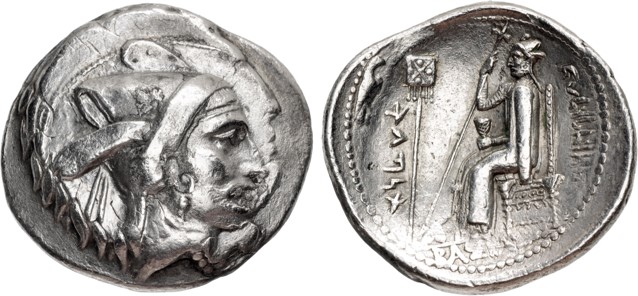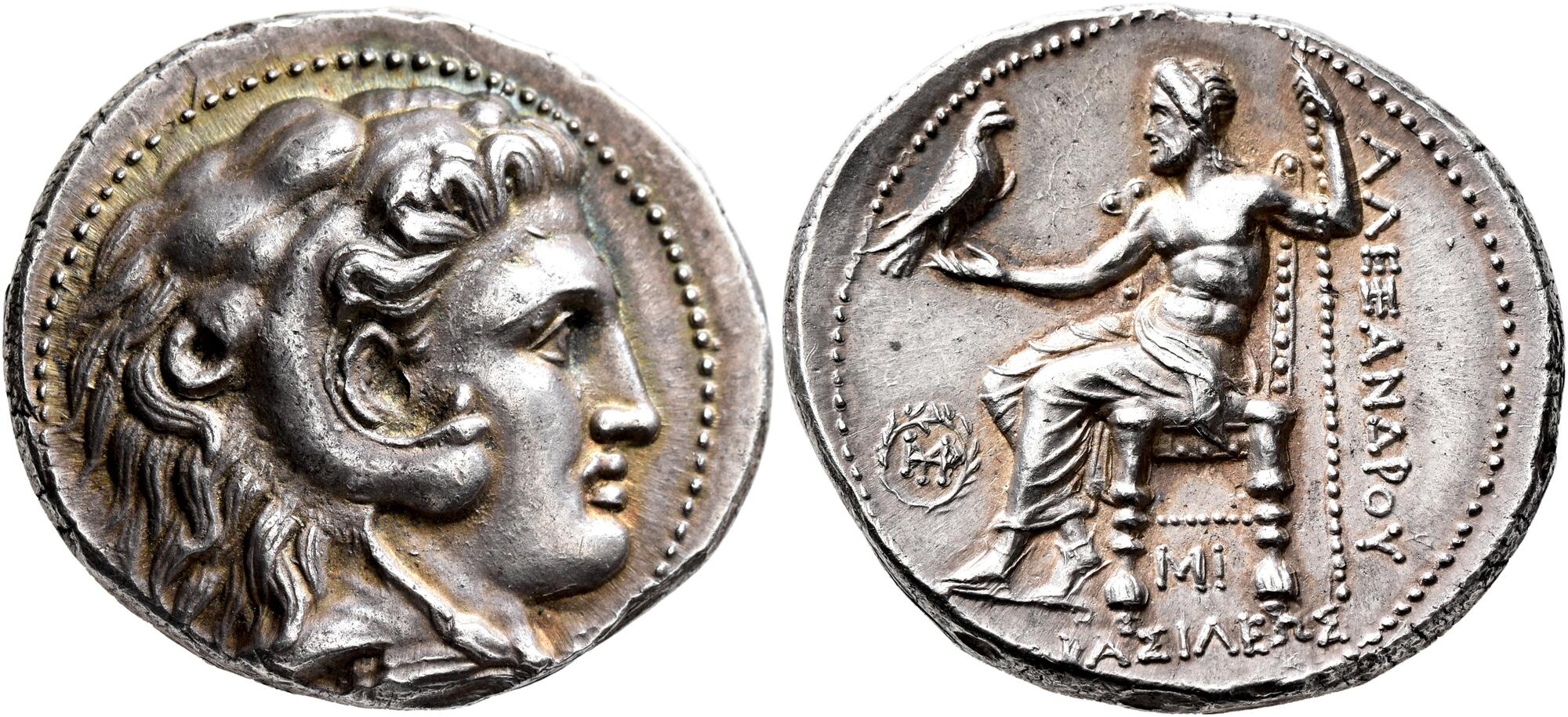299 BCE - 270 BCE | 𐡁𐡓𐡁 / 𐡀𐡍𐡄𐡏𐡀 bgdt prtrk' zy lhy bgwrt (="Baydad, son of Bagawart, dynast of the Gods")
Overstriking coin
Bayadat_Classical_Numismatic_Group, _126, _28_May_2024, _390.jpg
[1]
Overstruck variety
Seleucus_I_Babylon.jpg
[2]
|
|
Sale(s)Sale(s) ᵖ:
|
The New York Sale, LIV, 11 Jan. 2022, lot 136 = Classical Numismatic Group, 126, 28 May 2024, 390
|
|
|
|
Description
| ObverseInscription or printing placed on the obverse.:
|
Head of Baydad right, with short beard and mustache, wearing earing, satrapal cap (kyrbasia) with flaps tied behind and diadem.
|
ReverseInscription or printing placed on the reverse.:
|
𐡁𐡓𐡁 / 𐡀𐡍𐡄𐡏𐡀 bgdt prtrk' zy lhy bgwrt (="Baydad, son of Bagawart, dynast of the Gods") (Aramaic) Baydād enthroned left, wearing long cloak and kyrbasia, holding sceptre and cup, to left, standard.
|
Mint and issuing power
| MintIdentifies the place of manufacture or issue of a numismatic object.:
|
Istakhr (Persepolis)
|
Ancient regionAncient region.
|
Persis
|
Modern countryModern country: Iran
|
AuthorityIdentifies the issuing power. The authority can be "pretended" when the name or the portrait of X is on the coin but he/she was not the issuing power. It can also be "uncertain" when there is no mention of X on the coin but he/she was the issuing power according to the historical sources:
|
Baydad I of Persis, Kingdom of Persis
|
Chronology
| FromIdentifies the initial date in a range assigned in a numismatic context. 299 BCE toIdentifies the final date in a range assigned in a numismatic context.. 270 BCE
|
Hellenistic 323-30 BC  periodTime period of the numismatic object. periodTime period of the numismatic object.
|
Physical description
MetalThe physical material (usually metal) from which an object is made.: Silver 
|
WeightWeight of the numismatic object (in grams). in grams: 16.6916.69 g <br />16,690 mg <br />
|
DenominationTerm indicating the value of a numismatic object. Examples: tetradrachm, chalkous, denarius.: tetradrachm 
|
AxisDescribes the directional relationship between the obverse and reverse of a numismatic object.: 1212 mm <br />1.2 cm <br />
|
| DiameterDescribes diameter of an object (in mm).: 3232 mm <br />3.2 cm <br />
|
StandardStandard.: Attic
|
References
Description
| ObverseInscription or printing placed on the obverse.:
|
Beardless head of Heracles right wearing lion skin headdress
|
ReverseInscription or printing placed on the reverse.:
|
ΑΛΕΞΑΝΔΡΟΥ BAΣΙΛΕΩΣ (Greek) Zeus seated on stool-throne left, holding eagle on outstretched right hand and sceptre in left
|
Mint and issuing power
Chronology
| FromIdentifies the initial date in a range assigned in a numismatic context. 311 BCE toIdentifies the final date in a range assigned in a numismatic context.. 300 BCE
|
Hellenistic 323-30 BC  periodTime period of the numismatic object. periodTime period of the numismatic object.
|
Physical description
| DenominationTerm indicating the value of a numismatic object. Examples: tetradrachm, chalkous, denarius. ᵖ:
|
tetradrachm 
|
StandardStandard. ᵖ:
|
Attic
|
References
| Frequency of overstrikesFrequency of overstrikes:
|
frequent
|
Level of confidenceLevel of confidence of the identification:
|
sure
|
| RemarksRemarks:
|
"Overstruck on a Babylon I mint tetradrachm of Seleukos I (second satrapy and kingship, 312-281 BC) in the name and types of Alexander III (SC 82.5)"
|
References
- ^ Alram, Michael (1986), Iranisches Personennamenbuch. Band IV: Nomina Propria Iranica In Nummis, Vienna.
- ^ Klose, Dietrich O. A. - Müseler, Wilhelm (2008), Statthalter Rebellen Könige - Die Münzen aus Persepolis von Alexander dem Großen zu den Sasaniden, Munich, xii, 90 p.
- ^ Nelson, Bradley R. (2011), Numismatic Art of Persia: The Sunrise Collection Part I: Ancient- 650 BC to AD 650, Lancaster
- ^ van't Haaff, Peter A. (2012), "Catalogue of Persis Coinage, Ca. 280 B.C. – A.D. 228 : 34 Kings of 5 dynasties that ruled in Iran for 500 years,” Ancient Civilizations from Scythia to Siberia, 18, 2012, p. 207-272.
- ^ Houghton, Arthur - Lorber, Catharine C. - Hoover, Oliver D. (2008), Seleucid coins : a comprehensive catalogue. Part 2, Seleucus IV through Antiochus XIII, 2 v., New York - Lancaster - London, (xxx), 120 p. of plates : ill., maps, tables

